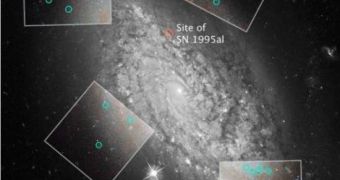The Hubble Constant is, in astronomical terms, the value given to the speed at which the Universe expands. It's unknown at this point, but mathematicians and physicists have narrowed its possible range down to about a five percent uncertainty rate. And while this is good news for those seeking to learn exactly how fast we are flying away from the center of the Cosmos, it's bad news for those looking to explain what dark matter is and how it was formed. Possible explanations for this phenomenon narrow, experts say, as Hubble's Constant comes closer to being accurately pinpointed.
According to recent calculations, the degree of uncertainty in the Hubble constant, or Ho, has decreased from more than five percent to approximately 3.6 percent. That is to say, the models reveal that the Universe is expanding at a speed of 74.2 kilometers per second per megaparsec, and that the error margin is of ± 3.6. The value is somewhat similar to the one proposed by Edwin Hubble himself, when he calculated it to be 72 ± 8 km/sec/megaparsec. However, experts now point out that the measurements that have led to the new results are twice as precise as the ones conducted by the astronomer.
In charge of the research is the Supernova Ho for the Equation of State (SHOES) team at the Space Telescope Science Institute and the John Hopkins University, led by renowned expert Adam Riess. The experts involved in the effort are currently seeking to introduce as many refinement and strengthening methods in their calculations as possible, so as to avoid even the smallest errors. At the scale of the calculus, the tiniest glitch multiplies exponentially and can render the entire result invalid. The scale that the scientists use is comparable to a one-billion-light-year-old line through space.
“It's like measuring a building with a long tape measure instead of moving a yard stick end over end. You avoid compounding the little errors you make every time you move the yardstick. The higher the building, the greater the error,” Riess explained, quoted by ScienceDaily. The team use Cepheid variables for their equations. These variables are, in fact, pulsating stars, located at certain reference points around our solar system. They couple readings from these celestial bodies with data obtained by using the billion-light-year-long “cosmic ladder.”
“Cepheids are the backbone of the distance ladder because their pulsation periods, which are easily observed, correlate directly with their luminosities. Another refinement of our ladder is the fact that we have observed the Cepheids in the near-infrared parts of the electromagnetic spectrum where these variable stars are better distance indicators than at optical wavelengths,” Texas A&M Professor of Physics and Astronomy Lucas Macri, who is a huge contributor to the new results, added.
“If you put in a box all the ways that dark energy might differ from the cosmological constant, that box would now be three times smaller. That's progress, but we still have a long way to go to pin down the nature of dark energy,” Riess said of the challenges of finding out the nature of dark energy.

 14 DAY TRIAL //
14 DAY TRIAL //